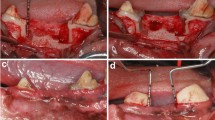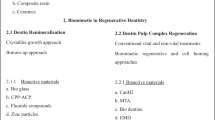Abstract
Purpose
This study aimed to evaluate the response of dental pulp stem cells (DPSCs) cultured with and without lipoteichoic acid (LTA) to different pulp-capping materials. Methods: The cells were cultured and seeded in 6-well plates and exposed to 1% LTA solution. Dycal, ProRoot MTA and Biodentine materials were applied on cells and all groups were evaluated by cell proliferation, viability, cell cycle and cell death signaling pathways for 24 and 72 h.
Results
LTA + Dycal treatment significantly inhibited the proliferation of DPSCs and increased the apoptosis rate of cells more than the other groups at 72 h. Compared to other groups, LTA + Dycal treatment significantly increased the levels of Caspase-3 and AKT and decreased the levels of p-AKT.
Conclusions
The results of this study revealed that all tested materials caused apoptosis in DPSCs via an extrinsic apoptotic pathway. The DPSCs showed an early apoptosis response to the Dycal and a late apoptosis response to the ProRoot MTA and Biodentine treatments. LTA led autophagy and inhibited the proliferation of DPSCs. ProRoot MTA and Biodentin eliminated the LTA's bioactivity with higher efficiency than Dycal.








Similar content being viewed by others
References
Banas AJ. Virulence properties of Streptococcus mutans. Front Biosci. 2004;1(9):1267–77.
Ryu YH, Baik JE, Yang JS, Kang SS, Im J, Yun CH, Kim DW, Lee K, Chung DK, Ju HR, Han SH. Differential immunostimulatory effects of Gram-positive bacteria due to their lipoteichoic acids. Int Immunopharmacol. 2009;9:127–33.
Nicolas GG, Lavoie MC. Streptococcus mutans and oral streptococci in dental plaque. Can J Microbiol. 2011;57:1–20.
Percy MG, Grundling A. Lipoteichoic acid synthesis and function in gram-positive bacteria. Annu Rev Microbiol. 2014;68:81–100.
Parolia A, Gee LS, De Moraes Porto ICC, Mohan M. Role of cytokines, endotoxins (LPS), and lipoteichoic acid (LTA) in endodontic infection. J Dent Oral Disord Ther. 2014;2:1–5.
Schwandner R, Dziarski R, Wesche H, Rothe M, Kirschning CJ. Peptidoglycan- and lipoteichoic acid-induced cell activation is mediated by toll-like receptor 2. J Biol Chem. 1999;18:17406–9.
Wang PL, Shirasu S, Daito M, Ohura K. Streptococcus mutans lipoteichoic acid induced apoptosis in cultured dental pulp cells from human deciduous teeth. Biochem Biophys Res Commun. 2001;9:957–61.
Matsuguchi T, Takagi A, Matsuzaki T, Nagaoka M, Ishikawa K, Yokokura T, Yoshikai Y. Lipoteichoic acids from Lactobacillus strains elicit strong tumor necrosis factor alpha-inducing activities in macrophages through Toll-like receptor 2. Clin Diagn Lab Immunol. 2003;10:259–66.
Botero TM, Mantellini MG, Song W, Hanks CT, Nor JE. Effect of lipopolysaccharides on vascular endothelial growth factor expression in mouse pulp cells and macrophages. Eur J Oral Sci. 2003;111:228–34.
Telles PD, Hanks CT, Machado MA, Nör JE. Lipoteichoic acid upregulates VEGF expression in macrophages and pulp cells. J Dent Res. 2003;82:466–70.
Han SH, Kim JH, Seo HS, Martin MH, Chung GH, Michalek SM, Nahm MH. Lipoteichoic acid-induced nitric oxide production depends on the activation of platelet-activating factor receptor and Jak2. J Immunol. 2006;1:573–9.
Ciardi JE, Rolla G, Bowen WH, Reilly JA. Adsorption of Streptococcus mutans lipoteichoic acid to hydroxyapatite. Scand J Dent Res. 1977;85:387–91.
Bergenholtz G. Inflammatory responses of the dental pulp to bacterial irritation. J Endod. 1981;7:100–4.
Siqueira JF, Rocas IN. Bacterial pathogenesis and mediators in apical periodontitis. Braz Dent J. 2007;18:267–80.
Horsted-Bindslev P, Lovshall H. Treatment outcome of vital pulp treatment. Endod Topics. 2002;2:24–34.
Prati C, Gandolfi MG. Calcium silicate bioactive cements: Biological perspectives and clinical applications. Dent Mater. 2015;31:351–70.
Torabinejad M, Parirokh M. Mineral trioxide aggregate: a comprehensive literature review—Part II: leakage and biocompatibility investigations. J Endod. 2010;36:190–202.
Bakland LK, Andreasen JO. Will mineral trioxide aggregate replace calcium hydroxide in treating pulpal and periodontal healing complications subsequent to dental trauma? A review. Dent Traumatol. 2012;28:25–32.
Natale LC, Rodrigues MC, Xavier TA, Simões A, de Souza DN, Braga RR. Ion release and mechanical properties of calcium silicate and calcium hydroxide materials used for pulp capping. Int Endod J. 2015;48:89–94.
Koubi G, Colon P, Franquin JC, Hartmann A, Richard G, Faure MO, Lambert G. Clinical evaluation of the performance and safety of a new dentine substitute, Biodentine, in the restoration of posterior teeth—a prospective study. Clin Oral Investig. 2013;17:243–9.
Safavi KE, Nichols FC. Effect of calcium hydroxide on bacterial lipopolysaccharide. J Endod. 1993;19:76–8.
Safavi KE, Nichols FC. Alteration of biological properties of bacterial lipopolysaccharide by calcium hydroxide treatment. J Endod. 1994;20:127–9.
Barthel CR, Levin LG, Reisner HM, Trope M. TNF-alpha release in monocytes after exposure to calcium hydroxide treated Escherichia coli LPS. Int Endod J. 1997;30:155–9.
Buck RA, Cai J, Eleazer PD, Staat RH, Hurst HE. Detoxification of endotoxin by endodontic irrigants and calcium hydroxide. J Endod. 2001;27:325–7.
Jiang J, Zuo J, Chen SH, Holliday LS. Calcium hydroxide reduces lipopolysaccharide stimulated osteoclast formation. Oral Surg Oral Med Oral Pathol Oral Radiol Endod. 2003;95:348–54.
Tanomaru JM, Leonardo MR, Tanomaru Filho M, Bonetti Filho I, Silva LA. Effect of different irrigation solutions and calcium hydroxide on bacterial LPS. Int Endod J. 2003;36:733–9.
Adl A, Motamedifar M, Shams MS, Mirzaie A. Clinical investigation of the effect of calcium hydroxide intracanal dressing on bacterial lipopolysaccharide reduction from infected root canals. Aust Endod J. 2015;41:12–6.
Baik JE, Kum KY, Yun CH, Lee JK, Lee K, Kim KK, Han SH. Calcium hydroxide inactivates lipoteichoic acid from Enterococcus faecalis. J Endod. 2008;34:1355–9.
Baik JE, Jang KS, Kang SS, Yun CH, Lee K, Kim BG, Kum KY, Han SH. Calcium hydroxide inactivates lipoteichoic acid from Enterococcus faecalis through deacylation of the lipid moiety. J Endod. 2011;37:191–6.
Chung M, Lee S, Chen D, Kim U, Kim Y, Kim S, Kim E. Effects of different calcium silicate cements on the inflammatory response and odontogenic differentiation of lipopolysaccharide-stimulated human dental pulp stem cells. Materials (Basel). 2019;17:1259–72.
Duque C, Hebling J, Smith AJ, Giro EM, Oliveira MF, de Souza Costa CA. Reactionary dentinogenesis after applying restorative materials and bioactive dentin matrix molecules as liners in deep cavities prepared in non-human primate teeth. J Oral Rehabil. 2006;33:452–61.
Chen L, Shen H, Suh BI. Bioactive dental restorative materials: a review. Am J Dent. 2013;26:219–27.
Agrafioti A, Taraslia V, Chrepa V, Lymperi S, Panopoulos P, Anastasiadou E, Kontakiotis EG. Interaction of dental pulp stem cells with Biodentine and MTA after exposure to different environments. J Appl Oral Sci. 2016;24:481–6.
Widbiller M, Lindner SR, Buchalla W, Eidt A, Hiller KA, Schmalz G, Galler KM. Three-dimensional culture of dental pulp stem cells in direct contact to tricalcium silicate cements. Clin Oral Investig. 2016;20:237–46.
Tomson PL, Grover LM, Lumley PJ, Sloan AJ, Smith AJ, Cooper PR. Dissolution of bio-active dentine matrix components by mineral trioxide aggregate. J Dent. 2007;35:636–42.
Laurent P, Camps J, De Méo M, Déjou J, About I. Induction of specific cell responses to a Ca(3)SiO(5)-based posterior restorative material. Dent Mater. 2008;24:1486–94.
Gandolfi MG, Siboni F, Primus CM, Prati C. Ion release, porosity, solubility and bioactivity of MTA Plus tricalcium silicate. J Endod. 2014;40:1632–7.
Morath S, Stadelmaier A, Geyer A, Schmidt RR, Hartung T. Synthetic lipoteichoic acid from Staphylococcus aureus is a potent stimulus of cytokine release. J Exp Med. 2002;17:1635–40.
Jin MS, Kim SE, Heo JY, Lee ME, Kim HM, Paik SG, Lee H, Lee JO. Crystal structure of the TLR1-TLR2 heterodimer induced by binding of a tri-acylated lipopeptide. Cell. 2007;21:1071–82.
Han SH, Kim JH, Seo HS, Martin MH, Chung GH, Michalek SM, Nahm MH. Pneumococcal lipoteichoic acid (LTA) is not as potent as staphylococcal LTA in stimulating Toll-like receptor 2. J Immunol. 2003;71:5541–8.
Eldeniz AU, Erdemir A, Hadimli HH, Belli S, Erganis O. Assessment of antibacterial activity of EndoREZ. Oral Surg Oral Med Oral Pathol Oral Radiol Endod. 2006;102:119–26.
Chang YC, Li PC, Chen BC, Chang MS, Wang JL, Chiu WT, Lin CH. Lipoteichoic acid-induced nitric oxide synthase expression in RAW 264.7 macrophages is mediated by cyclooxygenase-2, prostaglandin E2, protein kinase A, p38 MAPK, and nuclear factor-κB pathways. Cell Signal. 2006;18:1235–43.
Durand SH, Flacher V, Romeas A, Carrouel F, Colomb E, Vincent C, Magloire H, Couble ML, Bleicher F, Staquet MJ, Lebecque S, Farges JC. Lipoteichoic acid increases TLR and functional chemokine expression while reducing dentin formation in in vitro differentiated human odontoblasts. J Immunol. 2006;1:2880–7.
Kao SJ, Lei HC, Kuo CT, Chang MS, Chen BC, Chang YC, Chiu WT, Lin CH. Lipoteichoic acid induces nuclear factor-κB activation and nitric oxide synthase expression via phosphatidylinositol 3-kinase, Akt, and p38 MAPK in RAW 264.7 macrophages. Immunology. 2005;115:366–74.
Keller JF, Carrouel F, Colomb E, Durand SH, Baudouin C, Msika P, Bleicher F, Vincent C, Staquet MJ, Farges JC. Toll-like receptor 2 activation by lipoteichoic acid induces differential production of pro-inflammatory cytokines in human odontoblasts, dental pulp fibroblasts and immature dendritic cells. Immunobiology. 2010;215:53–9.
Keller JF, Carrouel F, Staquet MJ, Kufer TA, Baudouin C, Msika P, Bleicher F, Farges JC. Expression of NOD2 is increased in inflamed human dental pulps and lipoteichoic acid-stimulated odontoblast-like cells. Innate Immun. 2011;17:29–34.
Krysko O, Aaes TL, Kagan VE, D’Herde K, Bachert C, Leybaert L, Vandenabeele P, Krysko DV. Necroptotic cell death in anti-cancer therapy. Immunol Rev. 2017;280:207–19.
Pfeffer CM, Singh ATK. Apoptosis: a target for anticancer therapy. Int J Mol Sci. 2018. https://doi.org/10.3390/ijms19020448.
Galluzzi L, Vitale I, Aaronson SA, Abrams JM, Adam D, Agostinis P, Alnemri ES, Altucci L, Amelio I, Andrews DW. Molecular mechanisms of cell death: recommendations of the Nomenclature Committee on Cell Death 2018. Cell Death Differ. 2018. https://doi.org/10.1038/s41418-017-0012-4.
Maji S, Panda S, Samal SK, Shriwas O, Rath R, Pellecchia M, Emdad L, Das SK, Fisher PB, Dash R. Bcl-2 antiapoptotic family proteins and chemoresistance in cancer. Adv Cancer Res. 2018;137:37–75.
Sinha Hikim AP, Swerdloff RS. Hormonal and genetic control of germ cell apoptosis in the testis. Rev Reprod. 1999;4:38–47.
Tummers B, Green DR. Caspase-8: regulating life and death. Immunol Rev. 2017;277:76–89.
Zhang J, Wang G, Zhou Y, Chen Y, Ouyang L, Liu B. Mechanisms of autophagy and relevant small-molecule compounds for targeted cancer therapy. Cell Mol Life Sci. 2018;75:1803–26.
Erguven M, Bilir A, Yazihan N, Ermis E, Sabanci A, Aktas E, Aras Y, Alpman V. Decreased therapeutic effects of noscapine combined with imatinib mesylate on human glioblastoma in vitro and the effect of midkine. Cancer Cell Int. 2011;11:11–8.
Muramatsu H, Zou P, Muramatsu T. Stem cells and midkine. In: Erguven M, Muramatsu T, Bilir A, editors. Midkine: from embryogenesis to pathogenesis and therapy. Dordrecht, Netherlands: Springer; 2012. p. 203–10.
Cardone MH, Roy N, Stennicke HR, Salvesen GS, Franke TF, Stanbridge E, Frisch S, Reed JC. Regulation of cell death protease caspase-9 by phosphorylation. Science. 1988;13:1318–21.
Brunet A, Bonni A, Zigmond MJ, Lin MZ, Juo P, Hu LS, Anderson MJ, Arden KC, Blenis J, Greenberg ME. Akt promotes cell survival by phosphorylating and inhibiting a Forkhead transcription factor. Cell. 1999;19:857–68.
Inoki K, Li Y, Zhu T, Wu J, Guan KL. TSC2 is phosphorylated and inhibited by Akt and suppresses mTOR signalling. Nat Cell Biol. 2002;4:648–57.
Acknowledgements
This paper is a revised and expanded version of a paper entitled ‘Effect of calcium-silicate cements on Lipoteichoic acid-infected and healthy DPSCs’ presented at the AIC 19 th International Congress and CONSEURO, Bologna, Italy, 11-13 May 2017.
Funding
This study was supported by Turkish Scientific and Technological Research Council-TUBITAK [Project Number: 1001-115S431] and Research Fund of Istanbul University [THZ: 2016-20628, BEK: 2017-25051].
Author information
Authors and Affiliations
Contributions
ES, ME and SK designed the study. SK, TI, EA, YY, GD and ME performed the experiments. ES and ME wrote the manuscript. EOA performed the statistical analysis. All authors read and approved the final manuscript.
Corresponding author
Ethics declarations
Conflicts of interest
The authors declare that they is no conflict of interest regarding the publication of this Paper.
Additional information
Publisher's Note
Springer Nature remains neutral with regard to jurisdictional claims in published maps and institutional affiliations.
Rights and permissions
About this article
Cite this article
Kuru, S., Sepet, E., İrez, T. et al. Effects of different pulp-capping materials on cell death signaling pathways of lipoteichoic acid-stimulated human dental pulp stem cells. Odontology 109, 547–559 (2021). https://doi.org/10.1007/s10266-020-00571-3
Received:
Accepted:
Published:
Issue Date:
DOI: https://doi.org/10.1007/s10266-020-00571-3




